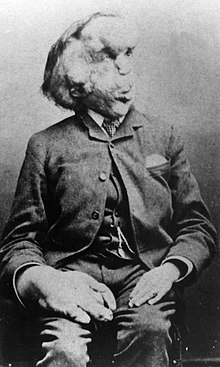
Back جوزيف ميريك Arabic چوزيف ميريك ARZ Joseph Merrick AST Джоузеф Мерик Bulgarian Joseph Merrick Catalan Joseph Merrick Czech Joseph Merrick Danish Joseph Merrick German Τζόζεφ Μέρικ Greek Joseph Merrick Esperanto
Joseph Merrick | |
|---|---|
 Merrick, c. 1889 | |
| Born | Joseph Carey Merrick 5 August 1862 Leicester, England |
| Died | 11 April 1890 (aged 27) London Hospital, Whitechapel, London, England |
| Resting place | Skeleton on display in Royal London Hospital Soft tissue buried at the City of London Cemetery and Crematorium |
| Other names | The Elephant Man John Merrick |
| Occupation | Artist |
| Years active | 1884–1885 |
| Known for | Physical deformities due to suspected Proteus syndrome |
| Height | 5 ft 2 in (157 cm) |
Joseph Carey Merrick (5 August 1862 – 11 April 1890), often erroneously called John Merrick, was an English artist known for his severe physical deformities. He was first exhibited at a freak show under the stage name "the Elephant Man", and then went to live at the London Hospital, in Whitechapel, after meeting Sir Frederick Treves, subsequently becoming well known in London society.
Merrick was born in Leicester and began to develop abnormally before the age of five. His mother died when he was eleven,[1] and his father soon remarried. Rejected by his father and stepmother, he left home and went to live with his uncle, Charles Merrick.[2] In 1879, 17-year-old Merrick entered the Leicester Union Workhouse.[3] In 1884, he contacted a showman named Sam Torr and proposed that he might be exhibited. Torr arranged for a group of men to manage Merrick, whom they named "the Elephant Man". After touring the East Midlands, Merrick travelled to London to be exhibited in a penny gaff shop rented by showman Tom Norman. The shop was visited by surgeon Frederick Treves, who invited Merrick to be physically examined. Merrick was displayed by Treves at a meeting of the Pathological Society of London in 1884,[4] after which Norman's shop was closed by the police.[5] Merrick then joined Sam Roper's circus and was toured in Europe.[6]
In Belgium, Merrick was robbed by his road manager and abandoned in Brussels. He eventually made his way back to the London Hospital,[7] where he was allowed to stay for the rest of his life. Treves visited him daily, and the pair developed a close friendship. Merrick also received visits from some of the wealthy ladies and gentlemen of London society, including Alexandra, Princess of Wales. Although the official cause of his death was asphyxia, Treves, who performed the postmortem, concluded that Merrick had died of a dislocated neck.
The exact cause of Merrick's deformities is unclear, but in 1986 it was conjectured that he had Proteus syndrome. In a 2003 study, DNA tests on his hair and bones were inconclusive because his skeleton had been bleached numerous times before going on display at the Royal London Hospital. Merrick's life was depicted in a 1977 play by Bernard Pomerance and in a 1980 film by David Lynch, both titled The Elephant Man.
- ^ Cite error: The named reference
Vigor-Mungovin61was invoked but never defined (see the help page). - ^ Cite error: The named reference
Vigor-Mungovin77was invoked but never defined (see the help page). - ^ Cite error: The named reference
Vigor-Mungovin83was invoked but never defined (see the help page). - ^ Treves, Frederick (1923). The Elephant Man and other Reminiscences (2016 ed.). London: Thomas Anker. p. 2. ISBN 978-1493725380.
- ^ Cite error: The named reference
Vigor-Mungovin120was invoked but never defined (see the help page). - ^ Cite error: The named reference
Vigor-Mungovin123was invoked but never defined (see the help page). - ^ Cite error: The named reference
Vigor-Mungovin141was invoked but never defined (see the help page).
© MMXXIII Rich X Search. We shall prevail. All rights reserved. Rich X Search